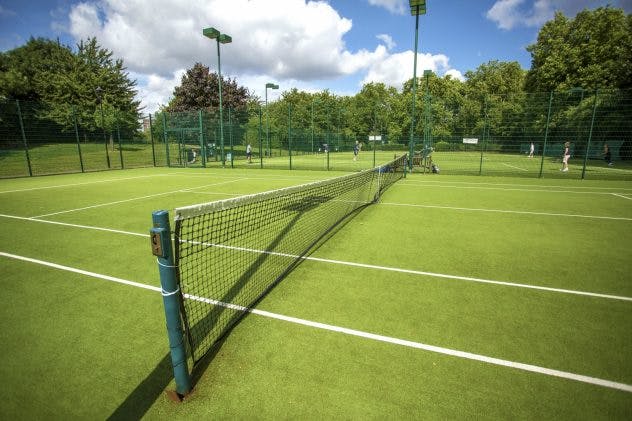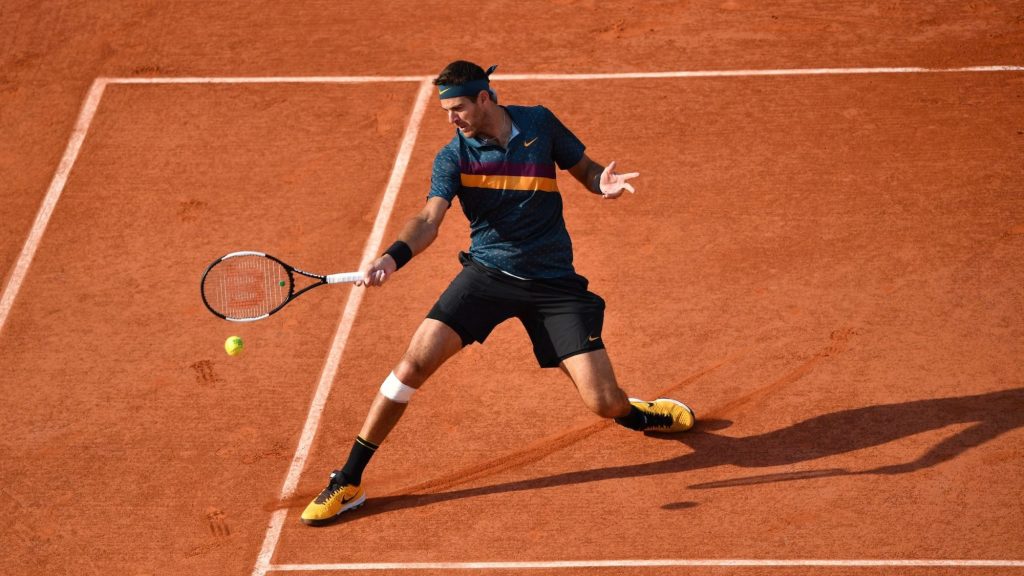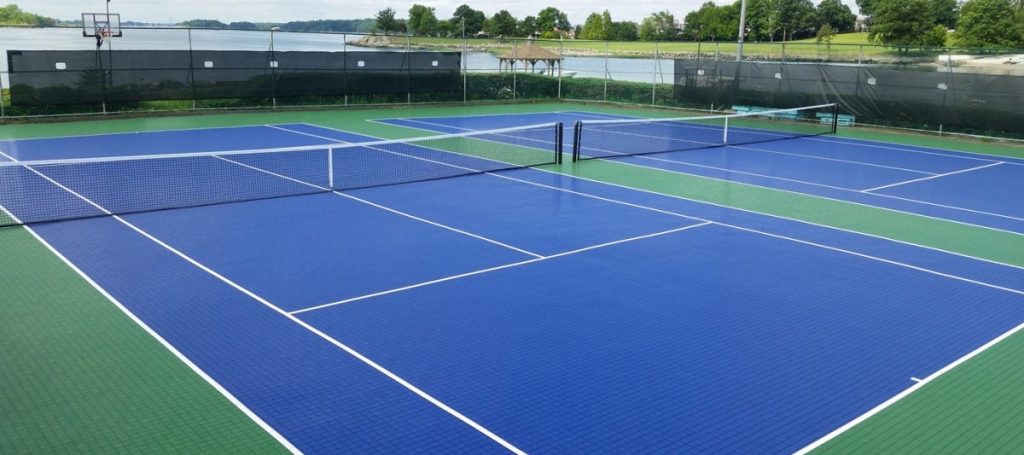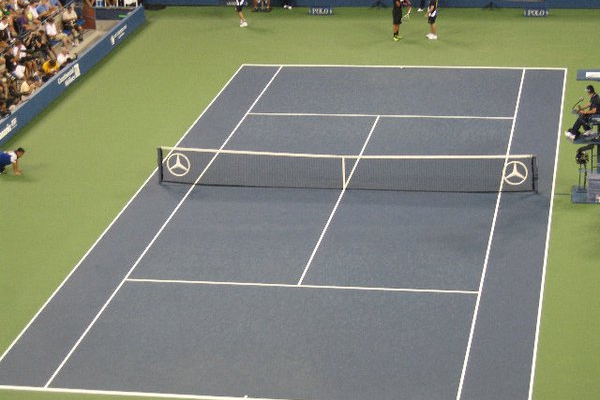Tennis, traditionally celebrated as a quintessential summer sport, has grown into a global phenomenon enjoyed by millions. At the core of the sport, beyond athleticism and strategy, is the tennis court. In the upcoming section of this article, we will explore the question, “how long is a tennis court?” providing insights into this vital aspect of the game.
Tennis Court dimensions and markings
According to the International Tennis Federation (ITF), the size of a tennis court is defined as a rectangular area 23.77 meters (78 feet) long. For doubles play, the court’s width is 10.97 meters (36 feet), while for singles, it narrows to 8.23 meters (27 feet). These standardized tennis court sizes are maintained worldwide to ensure a consistent playing environment, enabling players to develop and refine their skills on a universally recognized field of play. To further clarify, how big is a tennis court? It covers a total area of approximately 195 square meters (2,106 square feet) for doubles and 195 square meters (1,948 square feet) for singles.
Court markings
Each tennis court is meticulously outlined with several important markings:
- Baselines: These are the lines at the ends of the court where play begins for a point. Each baseline runs parallel to the net.
- Sidelines: These mark the longest edges of the court and differ in distance from the center depending on whether it’s a singles or doubles match.
- Service Lines: Located 6.40 meters (21 feet) from the net in each half of the court, these lines mark the bounds for a legal serve.
- Center Mark: A small mark at the midpoint of each baseline, serving as a reference point for players during serves.
The net’s role
The net stretches across the width of the court, dividing it into two equal halves. Its height is strictly regulated:
- At the posts, the net is 1.07 meters (3.5 feet) high, and it dips to 0.914 meters (3 feet) in the center, thanks to a cord or metal cable that pulls it tight.
The net’s height and placement are crucial as they affect the ball’s trajectory and the types of shots players can successfully execute during play. This strategic positioning encourages a variety of playing styles and tactics, impacting the game’s dynamic.
Understanding the specific dimensions of a tennis court and the purpose of its precise markings provides players and fans alike with deeper insights into the game, enhancing both playing and viewing experiences. These regulations ensure that the sport remains fair and competitive, regardless of the venue.
Types of tennis courts
Tennis is played on diverse surfaces, each contributing uniquely to the game’s dynamics and player strategies. The primary court types—grass, clay, and hard—each impact the style of play, ball behavior, and player tactics distinctly.
Grass Courts

- Origin and Build: Initially developed in 19th-century England, grass courts are the sport’s traditional surface, comprising tightly mown turf laid over compacted soil.
- Characteristics and Gameplay: Known for rapid play, the ball on grass courts skims low, encouraging brief rallies and benefiting players adept at serve-and-volley tactics.
- Player Dynamics: Fast conditions on grass tennis courts cater to aggressive players with robust serves and quick net play, a style mastered by tennis legends such as Roger Federer and Serena Williams.
Clay Courts

- Varieties of clay tennis courts:
- Red Clay: Common in Europe and South America, these courts are made of crushed brick and famously host the French Open.
- Green Clay: Known as “Har-Tru,” these are composed of crushed basalt, presenting a marginally quicker play than red clay.
- Gameplay Nuances: The slower pace and higher ball bounce on clay tennis courts favor endurance and strategic baseline exchanges.
- Strategic Considerations: Players like Rafael Nadal thrive on clay, utilizing their skill in long rallies and topspin to dominate.
Hard Courts

- Construction: Comprising asphalt or concrete bases coated with acrylic, hard courts provide a consistent bounce.
- Variations in Play: The amount of sand in the surface paint can vary, affecting the speed—some courts are designed for faster play, like those at the US Open, while others may encourage lengthier rallies.
- Game Dynamics: Typically faster than clay but slower than grass, hard courts offer a balanced environment suitable for versatile playing styles.
- Player Suitability: This surface suits players like Novak Djokovic and Serena Williams, who excel under varied conditions due to its predictable bounce and balanced pace.
Each court surface introduces different challenges and strategies, significantly influencing professional tennis tactics. Whether it’s the swift volleys on grass, the resilience-testing rallies on clay, or the strategic depth on hard courts, understanding these surfaces is crucial for mastering the game.
Significant tournaments and court types
The Grand Slam tournaments are renowned not only for their storied histories but also for the diverse court surfaces that play a critical role in shaping the games’ dynamics and outcomes.
Grand Slam Court Surfaces
- Wimbledon: Known for its longstanding traditions, Wimbledon remains the only Grand Slam contested on grass courts. This quick surface accelerates gameplay and highlights serve-and-volley strategies.
- French Open: Taking place at Roland Garros, this tournament is famous for its slow-playing red clay courts. The high bounce of the ball on this surface benefits players who are strong in stamina and prefer baseline strategies.
- US Open: This tournament features hard courts coated with an acrylic top layer, providing a balanced playing field that neither overly favors speed nor bounce, accommodating a variety of playing styles.
- Australian Open: Also held on hard courts, this event uses a Plexicushion surface, known for being slightly quicker than other hard courts, adding a unique twist to the gameplay.
Olympic Tennis Court Variety Historically, Olympic tennis has showcased a variety of surfaces, mirroring the host country’s preferences and infrastructure:
- Grass: The 2012 London Olympics famously used Wimbledon’s iconic grass courts, embracing a classic tennis environment.
- Hard and Clay: In more recent years, Olympic venues have alternated between hard and clay courts, with hard surfaces more commonly used due to their versatility and ease of maintenance.
This array of surfaces at significant tennis events not only challenges the adaptability of the athletes but also introduces a complex strategic layer to their matches. Each type of court demands distinct skills and adaptations, thereby enhancing the dynamic nature of mastering tennis.
Evolution and future of tennis courts
Carpet courts, once a staple in professional tennis, are made from removable materials like synthetic fibers. These courts were favored for their speed and indoor suitability. However, their presence in top-tier tournaments has waned over the decades.
Decline in professional settings
The decline of carpet courts in professional settings stems from their maintenance challenges and the evolution of playing styles that favor more durable and weather-resistant surfaces like hard and clay courts.
Future trends
Looking ahead, the future of tennis court surfaces appears to be embracing advanced materials and technology:
- Eco-friendly materials: Innovations may include more sustainable, durable materials that reduce environmental impact.
- Technology integration: Smart technologies could be integrated into court surfaces to enhance training capabilities and match analytics.
Mastering tennis: The impact of Court surfaces on gameplay
A thorough grasp of the various tennis court types is not only vital for players but also enriches the experience for enthusiasts. Knowledge of different court surfaces—grass, clay, and hard—allows both players and fans to deepen their strategic understanding of the game.
Strategic advantages of surface knowledge
- Enhanced performance: Players can tailor their tactics and techniques to suit the specific characteristics of each surface, potentially gaining a competitive edge.
- Richer viewing experience: Fans gain a more nuanced appreciation of the matches they watch, understanding how surface influences play style and player performance.
This intricate interaction between player and court is a fundamental aspect of tennis, a dynamic that adds depth and excitement to this globally beloved sport. By mastering these nuances, players can significantly enhance their performance, while fans gain a richer, more informed viewing experience.

Recent Comments